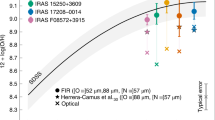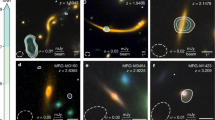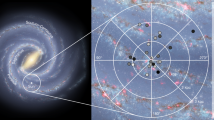Abstract
The first galaxies contain stars born out of gas with few or no ‘metals’ (that is, elements heavier than helium). The lack of metals is expected to inhibit efficient gas cooling and star formation1,2, but this effect has yet to be observed in galaxies with an oxygen abundance (relative to hydrogen) below a tenth of that of the Sun2,3,4. Extremely metal poor nearby galaxies may be our best local laboratories for studying in detail the conditions that prevailed in low metallicity galaxies at early epochs. Carbon monoxide emission is unreliable as a tracer of gas at low metallicities5,6,7, and while dust has been used to trace gas in low-metallicity galaxies5,8,9,10, low spatial resolution in the far-infrared has typically led to large uncertainties9,10. Here we report spatially resolved infrared observations of two galaxies with oxygen abundances below ten per cent of the solar value, and show that stars formed very inefficiently in seven star-forming clumps in these galaxies. The efficiencies are less than a tenth of those found in normal, metal rich galaxies today, suggesting that star formation may have been very inefficient in the early Universe.
This is a preview of subscription content, access via your institution
Access options
Subscribe to this journal
Receive 51 print issues and online access
$199.00 per year
only $3.90 per issue
Buy this article
- Purchase on Springer Link
- Instant access to full article PDF
Prices may be subject to local taxes which are calculated during checkout



Similar content being viewed by others
References
Ostriker, E. C., McKee, C. F. & Leroy, A. K. Regulation of star formation rates in multiphase galactic disks: a thermal/dynamical equilibrium model. Astrophys. J. 721, 975–994 (2010)
Krumholz, M. R. The star formation law in molecule-poor galaxies. Mon. Not. R. Astron. Soc. 436, 2747–2762 (2013)
Bigiel, F. et al. The star formation law in nearby galaxies on sub-kpc scales. Astron. J. 136, 2846–2871 (2008)
Bolatto, A. D. et al. The state of the gas and the relation between gas and star formation at low metallicity: the small Magellanic cloud. Astrophys. J. 741, 12–30 (2011)
Elmegreen, B. G. et al. Carbon monoxide in clouds at low metallicity in the dwarf irregular galaxy WLM. Nature 495, 487–489 (2013)
Bolatto, A. et al. The CO-to-H2 conversion factor. Annu. Rev. Astron. Astrophys. 51, 207–268 (2013)
Leroy, A. K. et al. The CO-to-H2 conversion factor from infrared dust emission across the Local Group. Astrophys. J. 737, 12–24 (2011)
Fisher, D. et al. The rarity of dust in metal-poor galaxies. Nature 505, 186–189 (2014)
Hunt, L. K. et al. ALMA observations of cool dust in a low-metallicity starburst, SBS 0335–052. Astron. Astrophys. 561, A49 (2014)
Rémy-Ruyer, A. et al. Gas-to-dust mass ratios in local galaxies over a 2 dex metallicity range. Astron. Astrophys. 563, A31 (2014)
Pettini, M. & Pagel, B. [OIII]/[NII] as an abundance indicator at high redshift. Mon. Not. R. Astron. Soc. 348, L59–L63 (2004)
Kniazev, A. Y. et al. Spectrophotometry of Sextans A and B: chemical abundances of H II regions and planetary nebulae. Astron. J. 130, 1558–1573 (2005)
Bergvall, N. & Ronnback, J. ESO 146–G14, a retarded disc galaxy. Mon. Not. R. Astron. Soc. 273, 603–614 (1995)
Wise, J. et al. The birth of a galaxy: primordial metal enrichment and stellar populations. Astrophys. J. 745, 50–59 (2012)
Sandstrom, K. M. et al. The CO-to-H2 conversion factor and dust-to-gas ratio on kiloparsec scales in nearby galaxies. Astrophys. J. 777, 5–37 (2013)
Poglitsch, A. et al. The Photodetector Array Camera and Spectrometer (PACS) on the Herschel Space Observatory. Astron. Astrophys. 518, L2 (2010)
Griffin, M. J. et al. The Herschel-SPIRE instrument and its in-flight performance. Astron. Astrophys. 518, L3 (2010)
Ott, J. et al. VLA-ANGST: A high-resolution HI survey of nearby dwarf galaxies. Astron. J. 144, 123–195 (2012)
Peters, S. P. C. et al. The shape of dark matter halos in edge-on galaxies: I. Overview of HI observations. Preprint at http://arxiv.org/abs/1303.2463 (2013)
Draine, B. T. & Li, A. Infrared emission from interstellar dust. IV. The silicate-graphite-PAH model in the post-Spitzer era. Astrophys. J. 657, 810–837 (2007)
Draine, B. T. et al. Andromeda’s dust. Astrophys. J. 780, 172–189 (2014)
Westmoquette, M. S. et al. Piecing together the puzzle of NGC 5253: abundances, kinematics and WR stars. Astron. Astrophys. 550, A88 (2013)
Leroy, A. et al. The star formation efficiency in nearby galaxies: measuring where gas forms stars effectively. Astrophys. J. 136, 2782–2845 (2008)
Daddi, E. et al. Different star formation laws for disks versus starbursts at low and high redshifts. Astrophys. J. 714, L118 (2010)
Cormier, D. et al. The molecular gas reservoir of 6 low-metallicity galaxies from the Herschel Dwarf Galaxy Survey. A ground-based follow-up survey of CO(1–0), CO(2–1), and CO(3–2). Astron. Astrophys. 564, A121 (2014)
Taylor, C. L., Kobulnicky, H. A. & Skillman, E. D. CO emission in low-luminosity, H I-rich galaxies. Astron. J. 116, 2746–2756 (1998)
Hunt, L. et al. The Spitzer view of low-metallicity star formation. III. Fine-structure lines, aromatic features, and molecules. Astrophys. J. 712, 164–187 (2010)
Kuhlen, M. et al. Dwarf galaxy formation with H2-regulated star formation. Astrophys. J. 749, 36–57 (2012)
Traficante, A. et al. Data reduction pipeline for the Hi-GAL survey. Mon. Not. R. Astron. Soc. 416, 2932–2943 (2011)
Piazzo, L. et al. Artifact removal for GLS map makers by means of post-processing. IEEE Trans. Image Process. 21, 3687–3696 (2012)
Morrissey, P. et al. The calibration and data products of GALEX. Astrophys. J. 173 (Supp.). 682–697 (2007)
Dale, D. A. et al. The Spitzer Local Volume Legacy: survey description and infrared photometry. Astrophys. J. 703, 517–556 (2009)
Engelbracht, C. W. et al. Metallicity effects on dust properties in starbursting galaxies. Astrophys. J. 678, 804–827 (2008)
Bertin, E. et al. SExtractor: Software for source extraction. Astron. Astrophys. Suppl. 117, 393–404 (1996)
Sauvage, M. Experiments in photometric measurements of extended sources. http://herschel.esac.esa.int/twiki/pub/Public/PacsCalibrationWeb/ExtSrcPhotom.pdf (2011)
Ali, B. Surface brightness comparison of PACS blue array with IRAS and Spitzer/MIPS images. https://nhscsci.ipac.caltech.edu/pacs/docs/Photometer/PICC-NHSC-TN-029.pdf (2011)
Paladini, R. et al. Assessment analysis of the extended emission calibration for the PACS red channel. https://nhscsci.ipac.caltech.edu/pacs/docs/Photometer/PICC-NHSC-TR-034.pdf (2012)
Paladini, R. et al. PACS map-making tools: analysis and benchmarking. http://herschel.esac.esa.int/twiki/pub/Public/PacsCalibrationWeb/pacs_mapmaking_report_ex_sum_v3.pdf (2013)
Elbaz, D. et al. GOODS-Herschel: an infrared main sequence for star-forming galaxies. Astron. Astrophys. 533, A119 (2011)
Egami, E. et al. The Herschel Lensing Survey (HLS): Overview. Astron. Astrophys. 518, L12 (2010)
Acknowledgements
Y.S. acknowledges support for this work from the Natural Science Foundation of China (NSFC), grant 11373021, the Strategic Priority Research Program ‘The Emergence of Cosmological Structures’ of the Chinese Academy of Sciences (CAS), grant XDB09000000, and Nanjing University grant 985. Y.G. acknowledges support from the NSFC (grants 11173059 and 11390373) and from the CAS Program (grant XDB09000000). J.W. was supported by the National 973 programme (grant 2012CB821805) and by the NSFC (grant 11173013). Z.-Y.Z. acknowledges support from the European Research Council (ERC) in the form of advanced grant COSMICISM. Q.G. was supported by the NSFC (11273015 and 11133001) and by the National 973 programme (grant 2013CB834905). We thank F. Bigiel for making his data points available to plot contours in Fig. 3, S. P. C. Peters for making available his H i gas map of ESO 146-G14 to us, and L. Piazzo for help in Herschel data reduction. Herschel is an ESA space observatory with science instruments provided by European-led Principal Investigator consortia and with important participation from NASA. This work was supported in part by the Spitzer Space Telescope, which is operated by the Jet Propulsion Laboratory, California Institute of Technology, under a contract with NASA. It was also supported in part by a NASA Herschel grant (OT2_yshi_3) issued by JPL/Caltech.
Author information
Authors and Affiliations
Contributions
Y.S. led the Herschel proposal, Herschel data reduction and the writing of the manuscript. L.A. helped develop Herschel observations and helped in the writing of the manuscript. G.H. and S.S. assisted in the Herschel proposal. All authors discussed and commented on the manuscript.
Corresponding author
Ethics declarations
Competing interests
The authors declare no competing financial interests.
Extended data figures and tables
Extended Data Figure 1 Multi-wavelength images of the two galaxies.
a, Images of Sextans A in (left to right) the far-ultraviolet, H i gas, 70 µm, 160 µm and 250 µm dust emission. The large circle is the star-forming disk, small circles are star-forming clumps, and ellipses are diffuse regions. b, Images of ESO 146-G14: wavebands and disks/ellipses as in a.
Rights and permissions
About this article
Cite this article
Shi, Y., Armus, L., Helou, G. et al. Inefficient star formation in extremely metal poor galaxies. Nature 514, 335–338 (2014). https://doi.org/10.1038/nature13820
Received:
Accepted:
Published:
Issue Date:
DOI: https://doi.org/10.1038/nature13820
This article is cited by
-
Massive stars in extremely metal-poor galaxies: a window into the past
Experimental Astronomy (2021)
-
E3 ubiquitin ligase Nedd4 inhibits AP-1 activity and TNF-α production through targeting p38α for polyubiquitination and subsequent degradation
Scientific Reports (2017)
-
Flow signaling and atherosclerosis
Cellular and Molecular Life Sciences (2017)
-
Carbon monoxide in an extremely metal-poor galaxy
Nature Communications (2016)
-
Caspases and their role in inflammation and ischemic neuronal death. Focus on caspase-12
Apoptosis (2016)
Comments
By submitting a comment you agree to abide by our Terms and Community Guidelines. If you find something abusive or that does not comply with our terms or guidelines please flag it as inappropriate.



